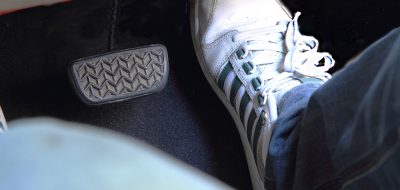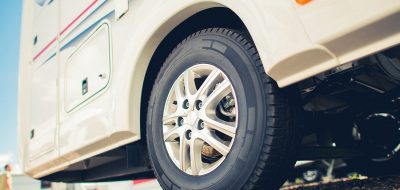|
RV Fuel Gremins — Onboard RV fuel wasters. Part IV in a Series.
Your motorhome’s engine-fuel consumption is primarily determined by how much horse power and torque you need. The more you use, the more fuel you will burn. But the power your engine puts out at the flywheel is not the same as what reaches the drive wheels. There are losses.
Radiator Fan Assembly
The engine radiator fan assembly requires a substantial amount of power when the thermo-clutch is locked up. This is when the ECM (Electronic Control Module) commands a higher rate of engine and component cooling. While there are different configurations of cooling packages on modern diesel pushers today, hydraulic and mechanical are both good choices. The hydraulic driven fans typically have two or more speeds that are engaged automatically as needed. The mechanical type uses a veritable magnetic field that allows slippage between the belt driven pulley and the fan driveshaft. This magnetic field strength is increased as temperatures dictate. When a high rate of cooling is required an internal clutch plate locks up driving the fan shaft at a 1 to 1 ratio. During these high cooling events a large power draw is needed from the engine.
Depending on the engine RPM, the horse power draw can be extremely high. Here’s an example of the HP lost to the fan assembly on a Cummins ISM and an ISX in the high cool mode.
| RPM | ISM | ISX |
| 1500 | 22 hp | 27 hp |
| 1900 | 45 hp | 53 hp |
| 2100 | 62+ hp | 70+ hp |
Of course there still is a draw, albeit far less, while operating at the low cooling need. While the high cooling typically operates at a 6 percent or so duty cycle, it can be ramped much higher in very hot weather, excessive dash air compressor needs, long grade climbs, high transmission temperatures, etc.
Drivetrain Drain
Then there are many other gremlins that constantly rob your fuel mileage. Drivetrain friction losses are a constant. Here energy is lost through the torque converter and the transmission group. Add in the driveshaft, differential and axle half shafts and you have a loss that really does not change.
The built in air compressor on a diesel pusher also consumes energy. When pumping to refresh the tank pressure it uses between 4 and 6 horse power depending on the engine speed. In the unloaded state, the draw drops to 0.5 to 1.0 HP. A 5 percent and up duty cycle can be expected in normal driving conditions. Constant on and off service brake actuation, fluctuating air suspension loads, or air leakage can increase this greatly.
More Culprits
Then there are the engine driven accessories such as the A/C compressor, alternator, and hydraulic pump. These all have varying loads, but basically are constantly consuming energy from the engine.
With all these factors straining your fuel tank, it can be easy to miss the warning light when gas runs low. Luckily, all Good Sam Roadside Assistance plans include emergency fuel and fluid services as a safety net should the worst occur and leave you stranded.
Next week we will look at the wild card, “The Human Factor.”
Peter Mercer – With the Onboard Constants








